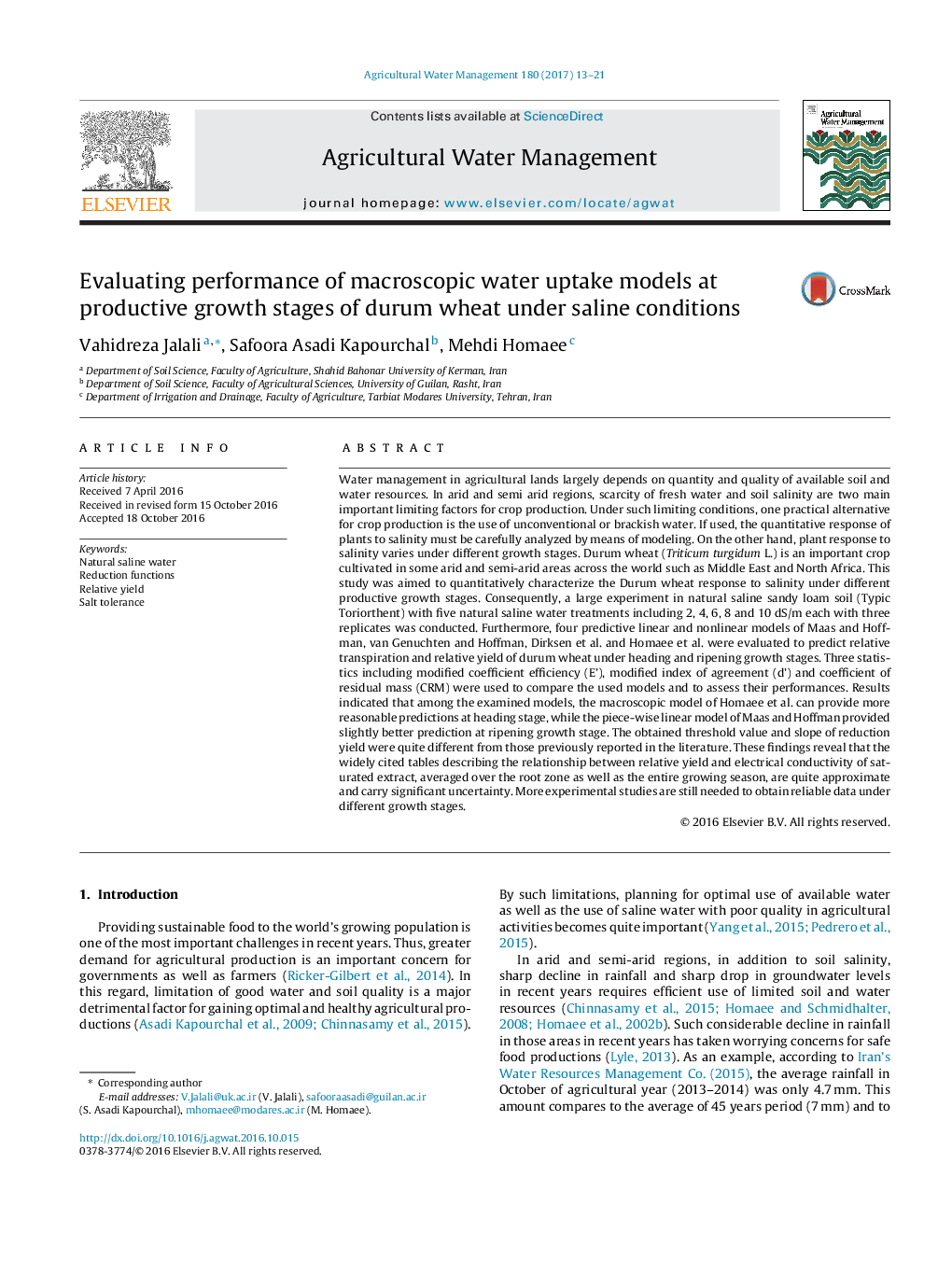| کد مقاله | کد نشریه | سال انتشار | مقاله انگلیسی | نسخه تمام متن |
|---|---|---|---|---|
| 5758442 | 1412760 | 2017 | 9 صفحه PDF | دانلود رایگان |
عنوان انگلیسی مقاله ISI
Evaluating performance of macroscopic water uptake models at productive growth stages of durum wheat under saline conditions
ترجمه فارسی عنوان
ارزیابی عملکرد مدل های جذب آب ماکروسکوپیک در مراحل رشد تولید گندم دوروم تحت شرایط شور
دانلود مقاله + سفارش ترجمه
دانلود مقاله ISI انگلیسی
رایگان برای ایرانیان
کلمات کلیدی
آب شور طبیعی توابع کاهش، عملکرد نسبی، تحمل نمک،
موضوعات مرتبط
علوم زیستی و بیوفناوری
علوم کشاورزی و بیولوژیک
علوم زراعت و اصلاح نباتات
چکیده انگلیسی
Water management in agricultural lands largely depends on quantity and quality of available soil and water resources. In arid and semi arid regions, scarcity of fresh water and soil salinity are two main important limiting factors for crop production. Under such limiting conditions, one practical alternative for crop production is the use of unconventional or brackish water. If used, the quantitative response of plants to salinity must be carefully analyzed by means of modeling. On the other hand, plant response to salinity varies under different growth stages. Durum wheat (Triticum turgidum L.) is an important crop cultivated in some arid and semi-arid areas across the world such as Middle East and North Africa. This study was aimed to quantitatively characterize the Durum wheat response to salinity under different productive growth stages. Consequently, a large experiment in natural saline sandy loam soil (Typic Toriorthent) with five natural saline water treatments including 2, 4, 6, 8 and 10 dS/m each with three replicates was conducted. Furthermore, four predictive linear and nonlinear models of Maas and Hoffman, van Genuchten and Hoffman, Dirksen et al. and Homaee et al. were evaluated to predict relative transpiration and relative yield of durum wheat under heading and ripening growth stages. Three statistics including modified coefficient efficiency (E'), modified index of agreement (d') and coefficient of residual mass (CRM) were used to compare the used models and to assess their performances. Results indicated that among the examined models, the macroscopic model of Homaee et al. can provide more reasonable predictions at heading stage, while the piece-wise linear model of Maas and Hoffman provided slightly better prediction at ripening growth stage. The obtained threshold value and slope of reduction yield were quite different from those previously reported in the literature. These findings reveal that the widely cited tables describing the relationship between relative yield and electrical conductivity of saturated extract, averaged over the root zone as well as the entire growing season, are quite approximate and carry significant uncertainty. More experimental studies are still needed to obtain reliable data under different growth stages.
ناشر
Database: Elsevier - ScienceDirect (ساینس دایرکت)
Journal: Agricultural Water Management - Volume 180, Part A, 31 January 2017, Pages 13-21
Journal: Agricultural Water Management - Volume 180, Part A, 31 January 2017, Pages 13-21
نویسندگان
Vahidreza Jalali, Safoora Asadi Kapourchal, Mehdi Homaee,
